Outbound sales development (SDR) plays a notable role in B2B sales strategies by proactively reaching potential customers. Unlike inbound SDRs, who handle incoming leads, outbound SDRs take a more targeted approach, searching for and contacting prospects. However, in 2024, research shows that more than 50% of SDRs are missing their quotas due to outdated methods.
In this blog, I will walk you through the different aspects of SDR, including the process and best practices for outbound SDRs. Additionally, I will explain inbound vs. outbound SDRs and provide steps to set up a high-performing SDR outbound team.
What Is Outbound Sales?
Outbound sales is the process of actively reaching out to potential customers to introduce and sell products or services. Unlike inbound sales, where leads come to you, outbound sales involves outbound SDRs (Sales Development Representatives) proactively engaging prospects through calls, emails, or social media. By targeting specific prospects, businesses can generate new opportunities, expand their customer base, and boost revenue growth effectively.
As an outbound SDR, always personalize your outreach. Start by researching your prospects to understand their needs and challenges. Craft your message in a way that resonates with them. Don't just sell—focus on how your solution can solve their specific problem. This approach builds trust, making it more likely they will engage and convert.
Inbound vs. Outbound SDR
Sales Development Representatives (SDRs) play a critical role in generating leads and driving revenue for businesses. However, the approach they use can vary significantly based on whether they focus on inbound or outbound sales strategies.
For example, inbound SDRs handle leads that come to your business through marketing efforts like content marketing, SEO, or social media. Their primary task is to engage outbound leads, qualify them, and move them further down the sales funnel.
On the other hand, outbound SDRs proactively reach out to potential customers who may not yet be aware of your offering. This involves identifying prospects, crafting personalized outreach messages, and engaging them through methods like cold calling, email, or social selling.
Check out the table below which compare the key attributes of Inbound vs Outbound SDR:
| Aspect | Inbound SDR | Outbound SDR |
| Lead Source | Warm leads via marketing efforts | Cold outreach to new prospects |
| Approach | Reactive | Proactive |
| Primary Tools | CRM, email | Cold calling, email, LinkedIn |
| Focus | Relationship-building | Lead generation |
In the end, the choice between inbound vs. outbound SDR depends on your business model, target audience, and resources. For example, startups may rely more on outbound SDR efforts to expand their reach, while established companies often balance both strategies to sustain growth.
The Process of Outbound Sales
Outbound sales is a proactive approach where your sales team initiates contact with potential customers instead of waiting for them to come to you. This structured sales process, often driven by an outbound SDR (Sales Development Representative) team, helps businesses generate new leads and close deals. Let’s break it down step by step for clarity.
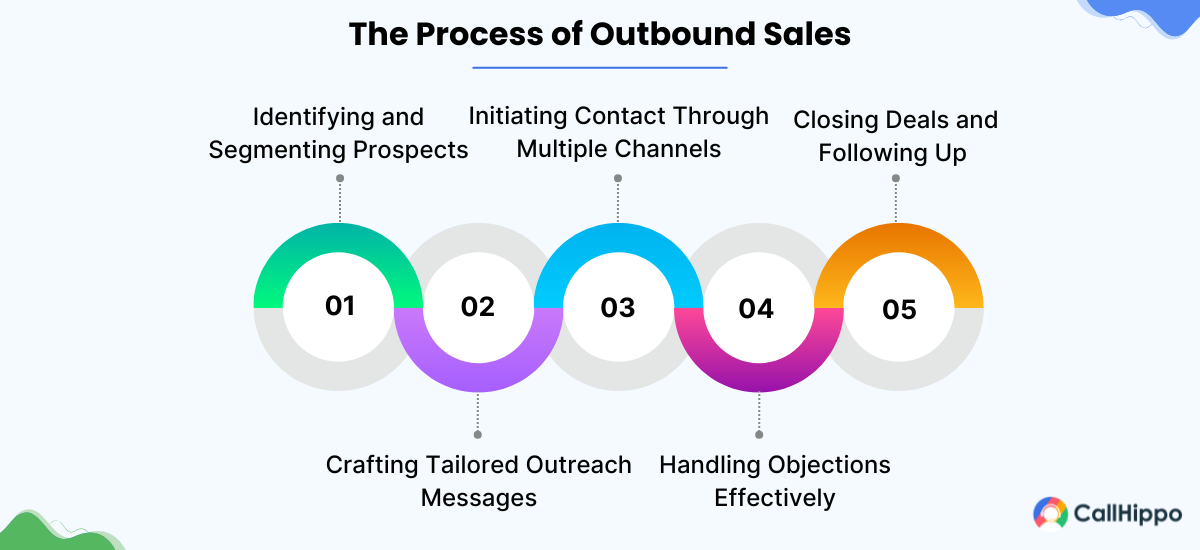
Step 1: Identifying and Segmenting Prospects
The first step in outbound sales is knowing who to target. Not everyone is a potential customer, so narrowing down your audience is key. Use data to identify prospects that align with your product or service. Tools like CRM systems or LinkedIn can help you find leads based on industry, job title, or company size.
Once identified, segment these prospects into categories. For example, you might create groups based on geography, revenue, or buying behavior. This segmentation allows you to tailor your outreach, ensuring a more personalized touch. A clear SDR outbound strategy starts with focusing on the right people.
Step 2: Crafting Tailored Outreach Messages
After identifying your prospects, it’s time to create compelling messages. Unlike generic templates, personalized outreach stands out. Start by addressing the recipient by name and referencing something specific about them or their company.
For instance, if you’re targeting a tech startup, mention how your solution aligns with their growth goals. Use easy-to-understand language and include a strong call to action, like scheduling a demo or having a quick chat. Remember, your message should solve a problem they are facing.
Step 3: Initiating Contact Through Multiple Channels
Relying on a single communication method isn’t enough in outbound sales. A successful outbound sales development approach uses multiple channels such as email, phone calls, LinkedIn messages, and even social media ads.
For example, you might start with an introductory email, follow up with a phone call, and then connect on LinkedIn. This multichannel approach ensures you’re engaging prospects where they feel most comfortable. Be consistent but not overwhelming—nobody likes spam!
Step 4: Handling Objections Effectively
Not everyone will say “yes” right away. Objections like “I don’t have the budget” or “I’m not interested” are common. An effective SDR outbound strategy includes preparation for these pushbacks.
Listen to the prospect’s concerns and empathize. Then, provide value by showing how your product can address their objections. For example, if budget is an issue, explain the long-term savings or ROI your solution offers. Handling objections calmly and professionally builds trust.
Step 5: Closing Deals and Following Up Strategically
Once you have built trust and addressed objections, it’s time to close the deal. Clearly explain the next steps, whether it’s signing a contract or scheduling an onboarding session. Use urgency, but don’t be pushy—phrases like “Let’s get started this week to see results faster” can work wonders.
After closing, don’t disappear. Strategic follow-ups show you care about the customer’s success. Check in periodically to ensure they are satisfied and address any issues promptly. This strengthens your relationship and opens doors for future sales or referrals.
Being pro at outbound sales will definitely take time, but these steps make the process smoother. When your outbound SDR team focuses on personalizing messages, using multiple ways to reach out, and handling objections well, they can achieve great results.
Best Practices for Outbound Sales Success
Outbound sales can be a game-changer if done right. Unlike inbound strategies, which wait for prospects to come to you, outbound SDR (Sales Development Representatives) proactively reach out to potential clients. Here’s how to build a winning SDR outbound strategy by following these best practices:
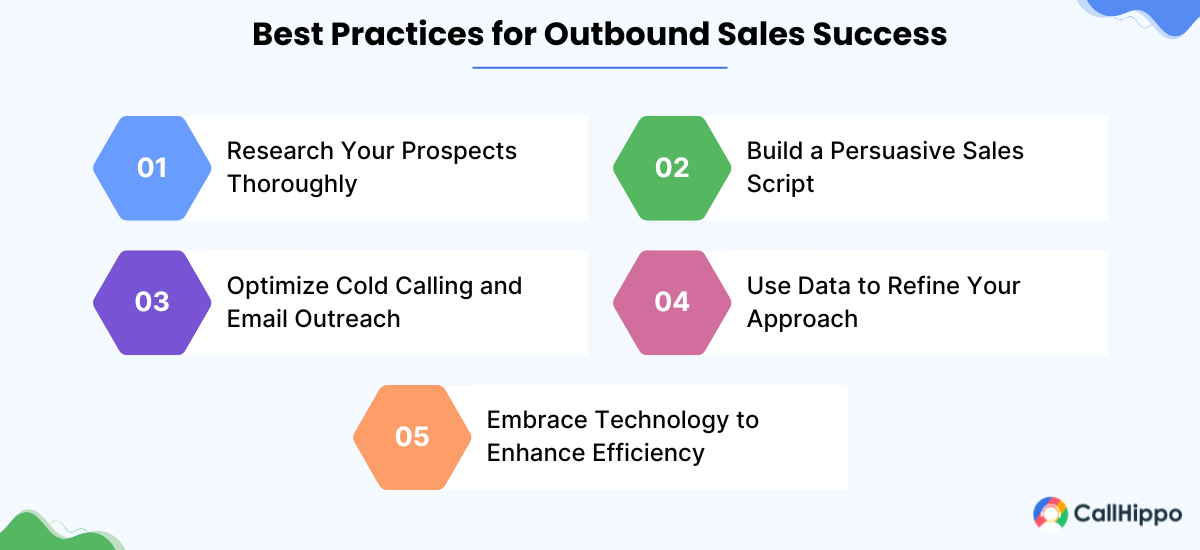
1. Research Your Prospects Thoroughly
The first and most important step in any outbound sales development strategy is researching your prospects. Understanding your target audience is crucial before reaching out. This means going beyond just gathering basic information like company name and industry. Instead, dig deeper into their pain points, goals, and the challenges they face.
For example, if your target customer is a startup looking to scale, understand their funding stage and the kind of solutions they may need. By investing time in thorough research, you can personalize your outreach and increase the likelihood of a positive response.
2. Build a Persuasive Sales Script
A well-crafted sales script is the foundation of any successful outbound SDR approach. However, it’s essential to make the script sound natural rather than robotic. The goal should be to initiate a conversation that feels human and relevant to the prospect. Your script should include a compelling value proposition, specific benefits, and tailored messaging that addresses the prospect’s unique pain points.
For example, you could say, “I understand that your team is facing challenges in automating manual processes, and I believe our product can help save you hours each week.” Remember to keep the conversation friendly and open, allowing the prospect to engage actively.
3. Optimize Cold Calling and Email Outreach
Cold calling and email outreach are common tactics used in outbound sales development. For cold calls, the key is to keep your message brief and focused on the value you can provide. Start by introducing yourself and explaining why you’re reaching out.
Avoid sounding pushy or intrusive. Similarly, for email outreach, make sure your subject line grabs attention without being misleading. Tailor the content of your email to the prospect’s needs, and always follow up in a timely manner. A well-written, relevant cold email can open doors, so crafting compelling messages is vital for outbound sales success.
4. Embrace Technology to Enhance Efficiency
The role of technology in outbound sales development can’t be overstated. From customer relationship management (CRM) tools to automated email sequences, technology can significantly streamline your process. With the right tools, you can schedule follow-ups, track prospect engagement, and measure performance, all in one place.
For example, tools like CallHippo empower SDRs to manage calls seamlessly, leveraging its AI-powered sentiment analysis and call performance tracking. Likewise, ControlHippo will help SDRs to integrate multiple communication channels into one single platform.
5. Use Data to Refine Your Approach
One of the most effective ways to optimize your outbound SDR strategy is by using data. Keep track of key metrics like response rates, conversion rates, and the average time it takes to move a prospect through the sales pipeline. Analyzing this data will help you identify what works and what doesn’t.
If you notice that certain types of outreach (like emails with a specific subject line) generate more responses, you can use this information to adjust your approach. The beauty of data is that it enables you to refine your strategy continuously and increase your chances of success.
To sum up, by researching prospects thoroughly, crafting persuasive sales scripts, optimizing cold calling and email outreach, using data to refine your approach, and embracing technology, outbound SDRs can significantly enhance their chances of success.
How to Set Up a High-Performing Outbound Sales Team?
Setting up a high-performing outbound sales team requires strategic planning, careful selection of team members, and ongoing support. Here’s how to build an efficient and productive outbound sales team.
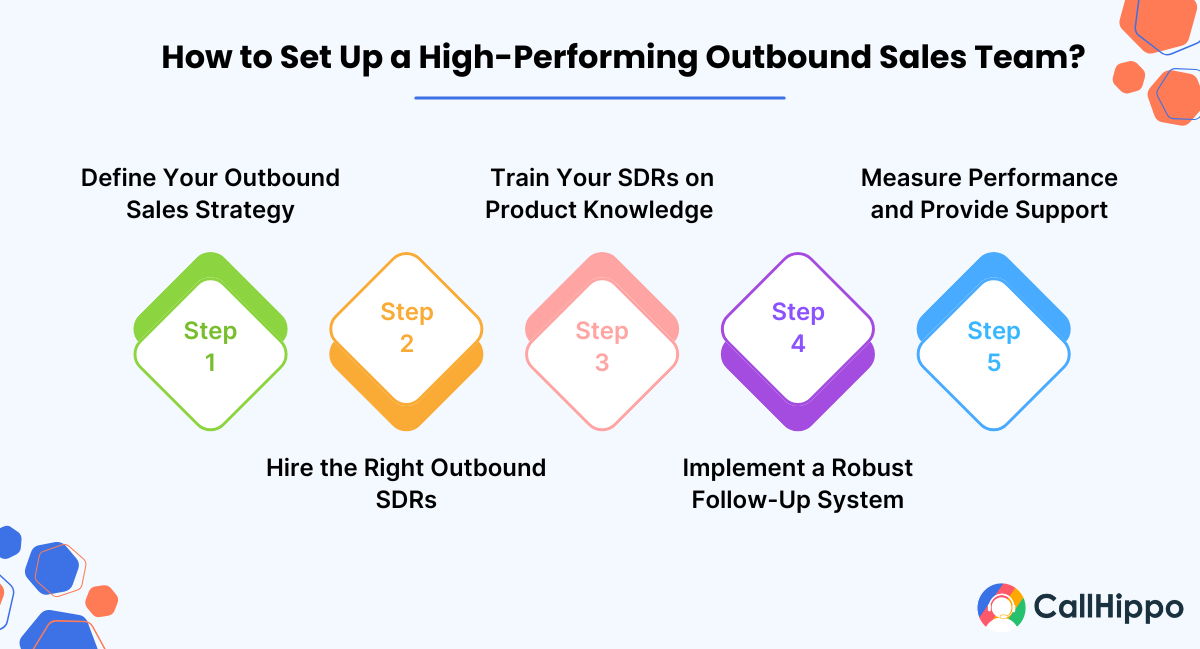
Step 1: Define Your Outbound Sales Strategy
Before you start hiring, it’s important to develop a clear outbound sales development (SDR) strategy. Your outbound SDR team will focus on reaching out to potential clients, often through cold calls, emails, and social media.
First, understand your target audience. Who are you selling to? What challenges are they facing that your solution can address? Craft messaging that resonates with this audience and use this in all outreach. Additionally, ensure your SDR team is aligned with your broader business goals, whether that’s lead generation, market expansion, or building long-term relationships.
Step 2: Hire the Right Outbound SDRs
The next crucial step is building the team. Look for candidates who possess a strong combination of communication, persistence, and research skills. Outbound SDRs should be comfortable initiating conversations with strangers, handling objections, and following up diligently.
In addition to these soft skills, ensure that your candidates are familiar with sales tools (CRM software, email outreach platforms) and have a basic understanding of the industry you’re in. Outbound SDRs should be motivated, resilient, and comfortable working with performance-based metrics.
Step 3: Train Your SDRs on Product Knowledge and Sales Tactics
Once your outbound sales team is in place, invest in training. Ensure that they understand your product or service inside and out, so they can confidently answer questions and tailor their pitch. They should also be equipped with effective sales tactics to engage with leads.
Teach your team the difference between inbound vs outbound SDR efforts. While inbound SDRs focus on leads coming through the funnel (e.g., via form submissions or website visits), outbound SDRs must proactively generate new leads through cold outreach. Equip your team with the skills to manage both types of sales processes effectively.
Additionally, give them a roadmap for prospecting. SDRs should have a clear idea of how to research leads, identify the right decision-makers, and approach them with compelling messages. Set clear goals and expectations, so the team knows what success looks like.
Step 4: Implement a Robust Follow-Up System
Outbound SDR: Key Statistics and Insights
- Outbound SDRs typically produce around 15 monthly meetings, with a 20% dropout rate. (Souce: Operatix)
- The average connect rate for outbound SDR calls is between 25-35%, indicating effective engagement. (Source: Koncert)
- About 70% of outbound SDRs rely on multi-touch strategies, including calls, emails, and social selling. (Source: Operatix)
- 40% of SDRs use automation tools to enhance efficiency and increase engagement volume. (Source: Koncert)
One of the most important aspects of an SDR outbound strategy is follow-up. A lot of sales happen after multiple touchpoints, so it’s essential to keep in touch with prospects without being too aggressive. Develop a system for tracking interactions, setting reminders, and scheduling follow-ups.
Automate certain parts of the follow-up process using CRM tools and email sequences, but always ensure there’s a personal touch. Your SDRs should be able to see the history of every prospect and tailor their follow-ups based on previous conversations or actions.
Step 5: Measure Performance and Provide Ongoing Support
Lastly, to ensure your outbound sales team is performing at its best, constantly measure performance. Set clear KPIs (Key Performance Indicators) such as the number of calls made, the number of qualified leads generated, and the conversion rates. Regularly review these metrics to identify areas for improvement.
Offer ongoing coaching and feedback, and recognize top performers. In a sales-driven environment, motivation is crucial, so maintain a positive atmosphere with regular team check-ins, training sessions, and reward systems.
By following these five steps, you can create a strong outbound sales development process that brings in quality leads and helps your business thrive.
Key Skills Every Outbound Sales Representative Should Have
To succeed in the SDR role, there are key skills that every outbound sales representative should possess. Here are five essential ones:
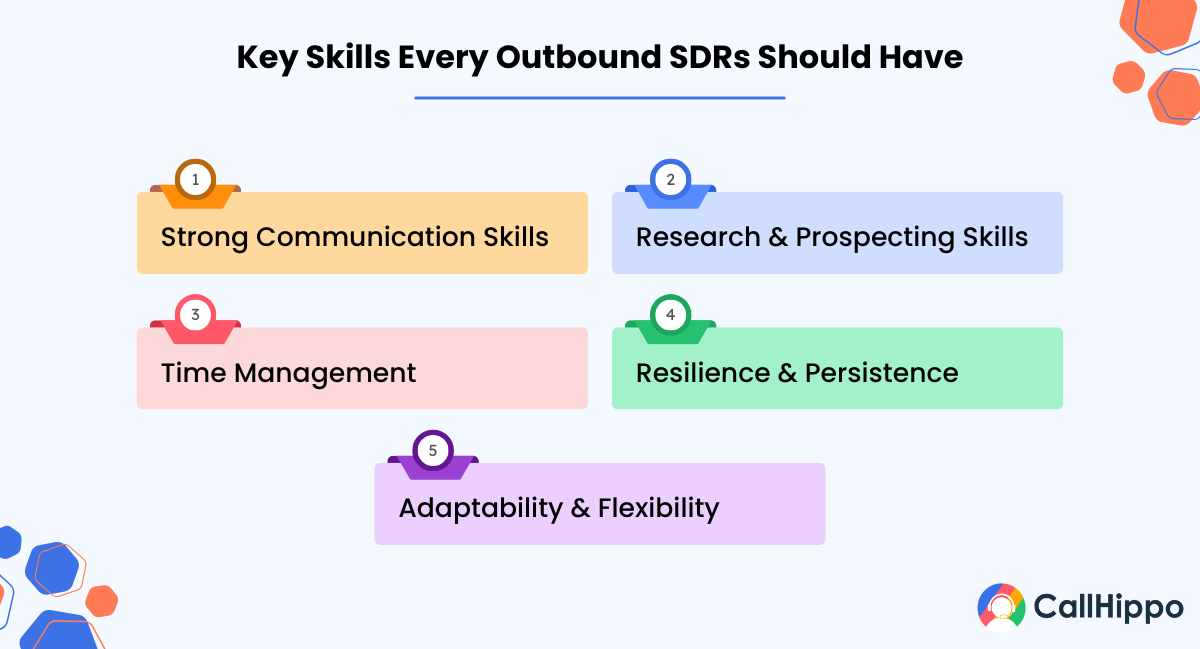
A. Strong Communication Skills
Outbound sales development is all about connecting with prospects. An effective outbound SDR must be able to communicate clearly and persuasively, both in writing and over the phone. Listening skills are just as important, allowing the SDR to understand a prospect’s needs and provide tailored solutions.
B. Research and Prospecting Skills
A successful outbound sales representative must be good at research. Knowing the target market and understanding the prospect’s business can help in creating a personalized pitch. Research skills allow SDRs to find high-quality leads and understand what will catch their attention.
C. Time Management and Organization
Outbound sales development involves managing multiple tasks, including calls, follow-ups, and meetings. Time management skills are crucial for staying on top of daily activities. An SDR should prioritize high-value prospects and make sure they are consistently reaching out to potential clients.
D. Resilience and Persistence
In outbound sales, rejection is common, and resilience is key. An outbound SDR should not be discouraged by “no” responses but should continue to pursue leads with persistence. Developing a thick skin and maintaining a positive attitude is crucial in staying motivated.
E. Adaptability and Flexibility
Every lead and situation is different. An SDR must quickly adapt their approach to meet the needs of the prospect. Understanding the difference between inbound vs outbound SDR strategies helps an outbound rep tailor their approach to each unique conversation.
Possessing these skills will help an outbound sales representative execute a well-planned SDR outbound strategy and contribute to the growth of the business.
Training and Coaching Tips for SDRs
To help SDRs perform better in their roles, training and coaching are essential. Here are 8 effective tips to enhance their skills and improve performance in their outbound SDR strategy.
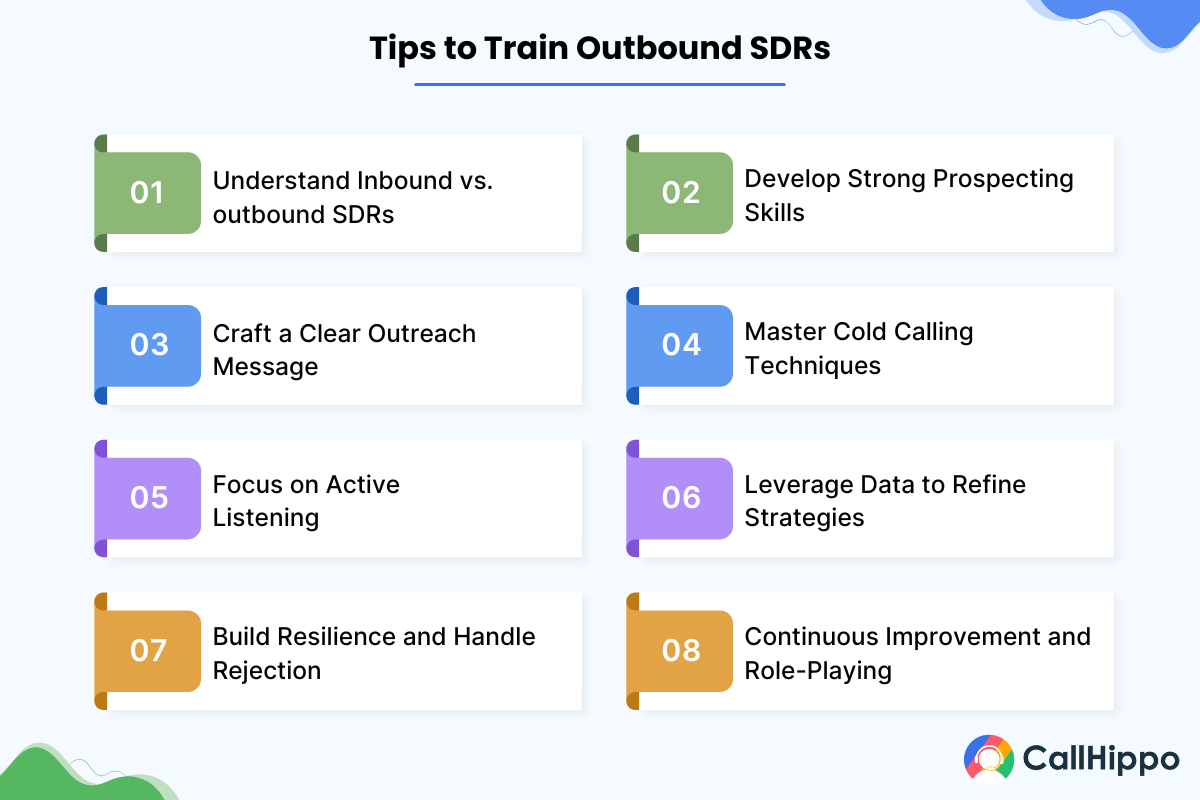
1. Understand the Difference Between Inbound and Outbound SDRs
Before diving into training, it’s important to clarify the role of an outbound SDR. While inbound SDRs respond to incoming leads, outbound SDRs take the proactive approach of reaching out to potential customers. Understanding this distinction helps SDRs tailor their approach and strategy, focusing on initiating conversations rather than just reacting to inquiries.
2. Develop Strong Prospecting Skills
Effective outbound SDRs need to be skilled at identifying high-potential leads. Training should focus on using various prospecting tools, like LinkedIn, social media, and CRM platforms, to gather insights. By understanding who the ideal customer is, SDRs can build a targeted list of prospects, improving the chances of converting leads into opportunities.
3. Craft a Clear Outreach Message
Outbound sales development depends heavily on the initial message sent to a prospect. Coaching SDRs to develop clear, concise, and personalized messages is key. The first impression matters, so make sure the message resonates with the prospect’s pain points and needs. Personalization increases engagement and sets the stage for meaningful conversations.
4. Master Cold Calling Techniques
Cold calling remains one of the most effective ways to reach potential clients in an outbound SDR strategy. However, it requires confidence and a strong script. Coaches should train SDRs to handle rejection, stay resilient, and use engaging language that captures attention within the first few seconds of the call.
5. Focus on Active Listening
A common mistake for SDRs is to talk more than they listen. Coaching should emphasize the importance of active listening. By understanding the prospect’s needs, pain points, and motivations, SDRs can better position their solutions, making the conversation more relevant and impactful.
6. Leverage Data to Refine Strategies
A successful outbound SDR strategy is data-driven. Encourage SDRs to use CRM tools and analytics to track outreach efforts and identify patterns that lead to success. By constantly reviewing and analyzing data, SDRs can refine their approach and improve conversion rates.
7. Build Resilience and Handle Rejection
In outbound sales development, rejection is inevitable. SDRs must learn to bounce back quickly and not take rejection personally. Training should include techniques for staying motivated, such as celebrating small wins, focusing on the bigger picture, and keeping a positive mindset.
8. Continuous Improvement and Role-Playing
To keep skills sharp, SDRs should engage in ongoing training, including role-playing exercises. Simulating real sales conversations allows them to practice different scenarios, refine their techniques, and receive constructive feedback. This helps SDRs improve their confidence and adaptability.
By applying these training and coaching tips, your SDRs can develop an effective outbound strategy, build stronger relationships with prospects, and achieve better sales outcomes.
Metrics to Track and Improve Team Performance
To improve team performance, especially in outbound sales development, it’s crucial to track key metrics. Here are eight important metrics to focus on:
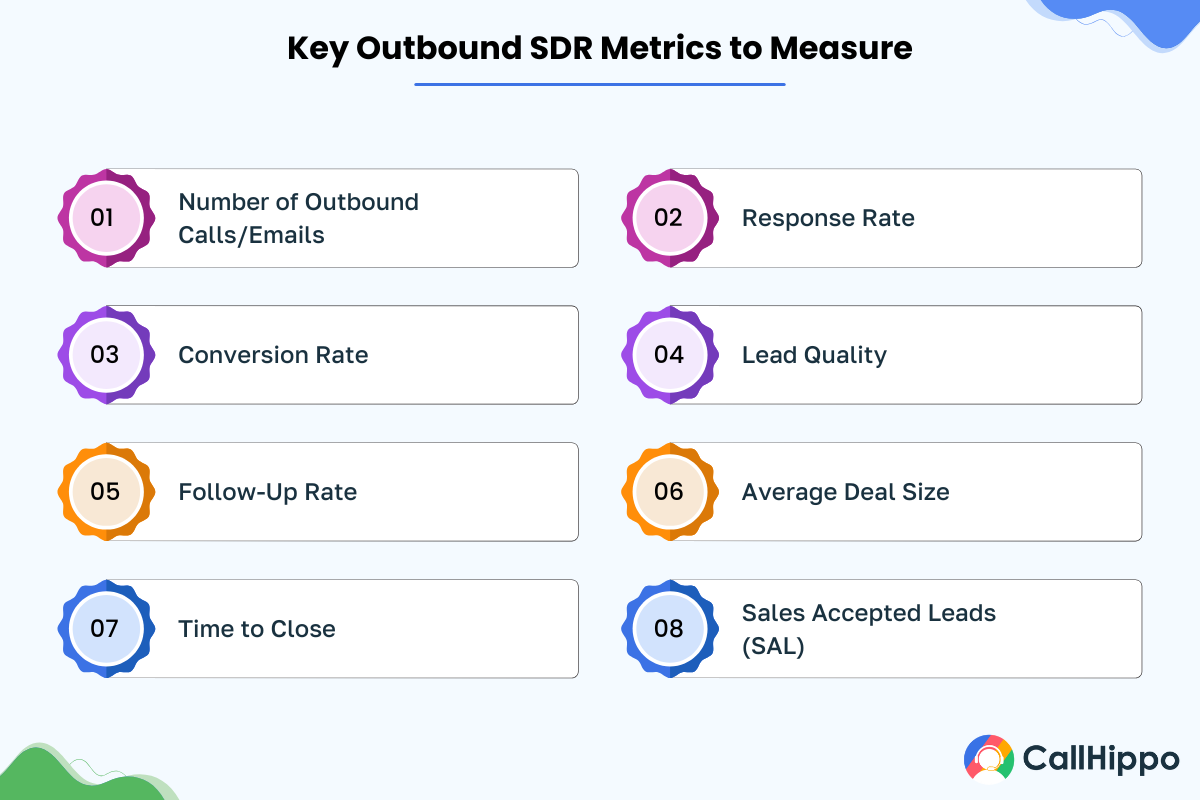
- Number of Outbound Calls/Emails: The number of calls or emails an outbound SDR makes is a basic yet essential metric. It shows how proactive the team is in reaching out to prospects.
- Response Rate: How many of those calls or emails lead to a response? This metric helps assess the quality of outreach and the effectiveness of the SDR outbound strategy.
- Conversion Rate: This tracks the percentage of responses that turn into qualified leads or meetings. High conversion rates indicate that the SDRs are targeting the right audience and delivering value.
- Lead Quality: Not all leads are created equal. Tracking lead quality ensures your team focuses on high-potential prospects, which is essential for outbound sales development success.
- Follow-Up Rate: A strong follow-up strategy is key in outbound SDR. This metric measures how often SDRs follow up with leads after the initial outreach.
- Average Deal Size: This measures the revenue potential of the leads being pursued. It helps teams gauge whether they are focusing on outbound leads that bring in the most value.
- Time to Close: This tracks the average time it takes for an SDR to close a deal. Shorter times generally suggest a more efficient and effective outbound SDR strategy.
- Sales Accepted Leads (SAL): This is the number of leads that your sales team accepts after being passed from the SDR team. It’s a sign of how well your outbound SDR team is qualifying leads.
By consistently monitoring these metrics, you can improve your SDR outbound strategy, maximize efficiency, and boost your team’s performance.
Conclusion: To sum up, becoming a pro at the outbound SDR role means having a clear plan. By knowing the difference between inbound and outbound SDR, you can focus on reaching the right people. A solid outbound sales development strategy helps you regularly find qualified leads, which keeps your sales pipeline strong. With determination, good communication, and the right tools, an outbound SDR can really help a business grow. Remember, a good SDR outbound strategy is essential for lasting success in sales.

Subscribe to our newsletter & never miss our latest news and promotions.









